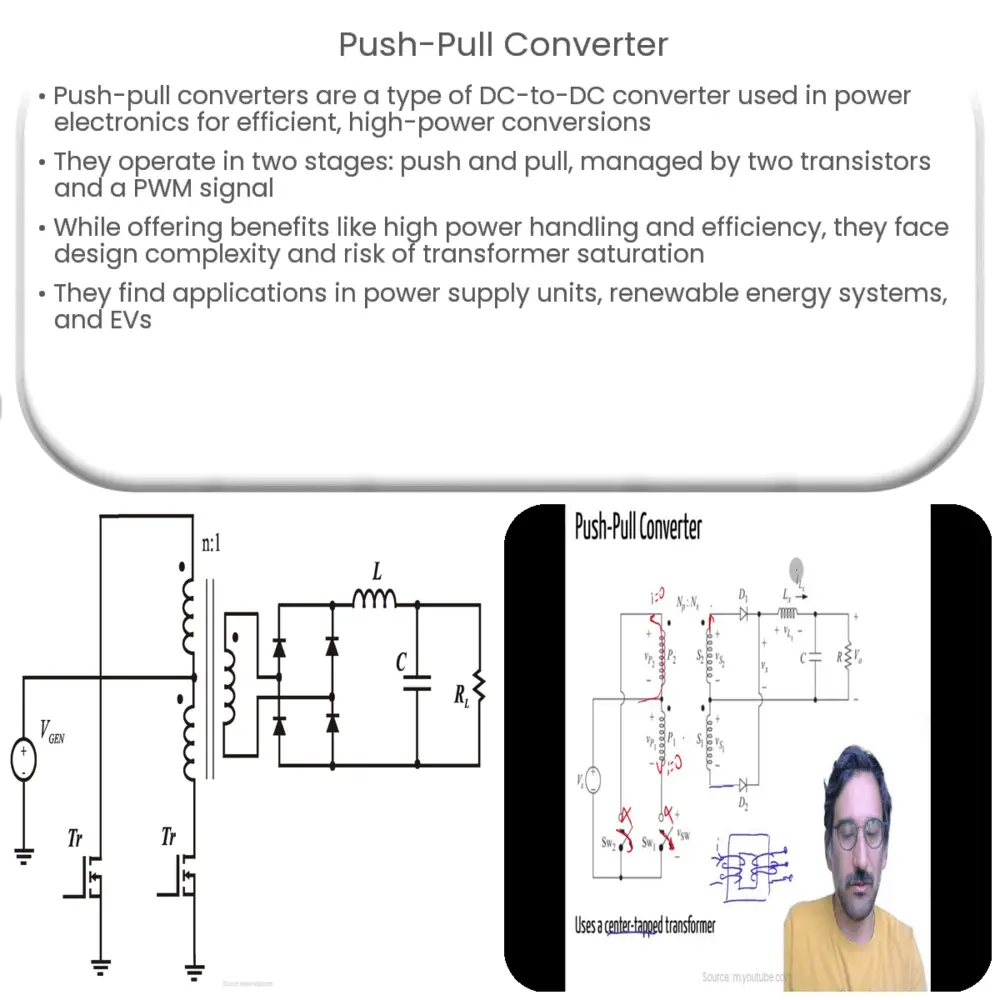Explore the workings, advantages, and applications of push-pull converters in power electronics, alongside key design considerations.

Introduction to Push-Pull Converters
A push-pull converter is a type of DC-to-DC converter, a common tool used in power electronics. These converters are vital in applications where the conversion of electrical power from one form to another is required, such as in computer power supplies, electric vehicle chargers, and renewable energy systems.
Working Principle of Push-Pull Converters
The basic operation of a push-pull converter involves two stages: the push stage and the pull stage. In the push stage, power is stored in a transformer by one transistor, and in the pull stage, power is released from the transformer by a second transistor. The two transistors are typically controlled by a pulse width modulation (PWM) signal, which alternates between the two transistors to maintain the balance of power transfer.
- Push Stage: The first transistor is switched on (push), allowing current to flow from the DC input source through the first half of the primary winding of the transformer. This creates a magnetic field that stores energy in the transformer.
- Pull Stage: The second transistor is switched on (pull), allowing current to flow through the second half of the primary winding of the transformer in the opposite direction. This collapses the magnetic field, releasing the energy stored in the transformer to the load.
Advantages of Push-Pull Converters
Push-pull converters are widely utilized due to their numerous benefits, which include their ability to handle high power levels, their high efficiency, and the presence of a transformer that provides electrical isolation between the input and output.
- High Power Handling: Push-pull converters are capable of handling higher power levels compared to other types of DC-to-DC converters. This is because the power is split between two transistors, allowing each to handle a portion of the power load.
- High Efficiency: Push-pull converters typically exhibit high efficiency due to their operation mode. They use both halves of the transformer’s primary winding, reducing copper losses and improving overall efficiency.
Next, we’ll explore the disadvantages and practical applications of push-pull converters, and delve into some key design considerations.
Disadvantages of Push-Pull Converters
Despite their numerous advantages, push-pull converters do have some drawbacks that need to be considered during design and implementation.
- Complexity: The design and control of push-pull converters can be complex due to the need for precise timing in switching between the two transistors. This requires sophisticated control algorithms, adding to the design complexity.
- Transformer Saturation: Push-pull converters are prone to transformer saturation if there is an imbalance in the duty cycles of the two transistors. This can lead to reduced efficiency and potential damage to the converter.
Applications of Push-Pull Converters
Push-pull converters find a wide range of applications across various sectors due to their high power handling capability and efficiency.
- Power Supply Units: They are often used in the power supply units of electronic devices like computers and servers, where efficient power conversion is required.
- Renewable Energy Systems: In renewable energy systems such as solar inverters, push-pull converters are used to convert the DC power generated into a more usable form.
- Electric Vehicles: In the charging systems of electric vehicles, these converters are used to manage and regulate the flow of power.
Design Considerations
Designing a push-pull converter involves several important considerations. The power level, input and output voltage requirements, and efficiency needs must be taken into account. The choice of components, particularly the transistors and transformer, is also critical. They should be chosen to handle the power levels involved, and to ensure that the transformer does not saturate under normal operating conditions.
Conclusion
In conclusion, push-pull converters play a vital role in power electronics, offering a robust solution for high-power, efficient DC-to-DC conversion. While they have some inherent challenges, including design complexity and the risk of transformer saturation, their benefits typically outweigh these drawbacks, making them an ideal choice for a range of applications. As with all engineering solutions, understanding the trade-offs and making informed design choices is key to leveraging the potential of push-pull converters.

